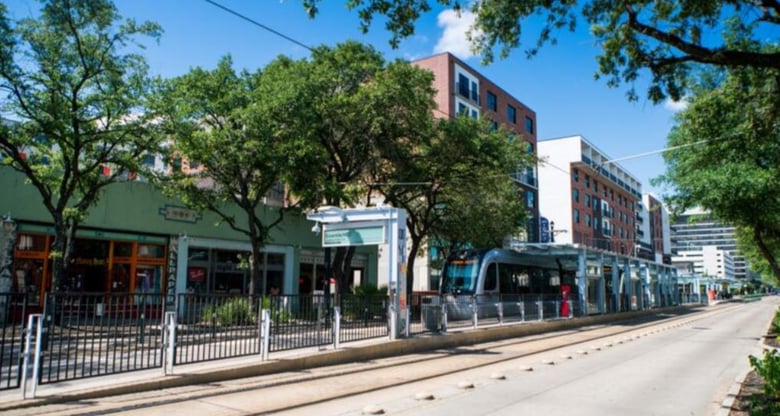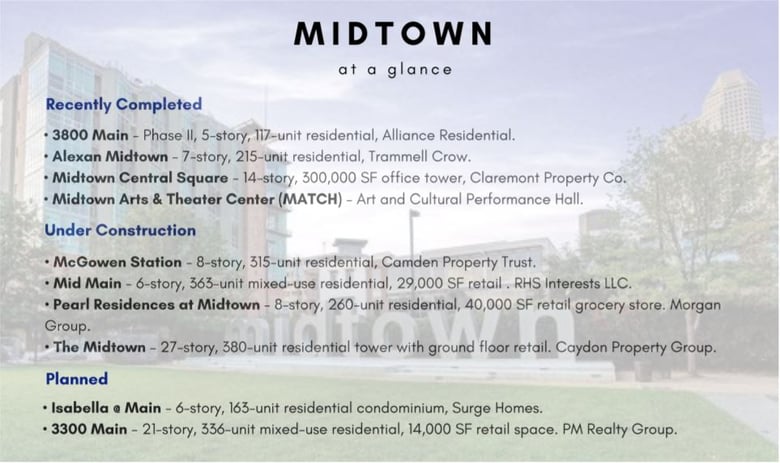Location, Location, Location
Posted by Surge Homes on in Media Coverage

Why Developers are Snatching Up Properties Near METRORail

The face of Midtown is changing. An ever-growing number of chic restaurants, watering holes, and modern mid-rises are taking up residence in the historic neighborhood. Pedestrians and cyclists casually cruise by new storefronts. News announcing that the city’s new innovation and technology hub will be housed in the former Midtown Sears building further validates the fact that big things are happening here.
“Where public transportation goes, community grows.” It’s a slogan that illustrates how public transportation not only provides essential mobility to millions of Americans, but also anchors communities and drives economic development. It is no coincidence that neighborhoods like Midtown are seeing a wave of interest and investment.
Back in 2004, the initial segment of METRO’s first light-rail line was completed. The Red Line gave residents in Houston’s Midtown neighborhood a new transportation option along Main Street which offered fast and convenient connections to Downtown, the Museum District, Texas Medical Center and NRG Stadium. Expansion of the system made connections to destinations like the Theater District, EADO and the University of Houston possible.
Fast-forward to 2018, Midtown is in the midst of a real estate boom – a boom that includes a number of transit-oriented developments. It makes sense. Numerous studies suggest more people are yearning for a hassle-free lifestyle in communities where they can live, work and play.
“Transit-oriented developments in Midtown have been key in the improved walkability in Midtown,” said Marlon Marshall, Director, Engineering and Construction at Midtown Redevelopment Authority. “Because many transitoriented developments provide housing, employment, commercial and recreational destinations nearby, automobile traffic is reduced. This results in increased pedestrian activity.”
All that increased sidewalk traffic doesn’t just make a community more interesting and vibrant, it’s also good for business. More activity draws more people which brings more businesses – boosting economic activity and creating a “virtuous” cycle.
Marshall adds that because Midtown is one of Houston's most walkable neighborhoods, having METRORail nearby gives people a very important mobility option for connectivity to places of employment, health care, arts, entertainment and nightlife.

Australian developer Caydon Properties is one of several development companies building in Midtown. It is currently constructing a $200 million residential tower at the corner of Main and Tuam, along METRO’s Red Line. Once complete, the 27-story building will offer 357 apartments and street-level retail space for shops and restaurants.
Caydon’s Principal, Joe Russo, says his company carefully selects locations that provide the best everyday life experiences a city can offer.
“Our sites are positioned in established neighborhoods close to downtown which boast a wealth of recreational opportunities,” said Russo. “This includes proximity to great dining destinations, wine bars, coffee shops, leisure options and frequent public transport.”
Louis Conrad is president of Surge Homes. His company's 163-unit condominium project, Isabella at Midtown, is located at 4001 Main, just steps from METRO's Red Line. Conrad said his company foresaw Midtown’s potential back in 2007.
"In 2007, the value of walkability and public transportation was not as obvious as it is today," he said. "However, our company had successfully built transit-oriented developments in other cities and we wanted to replicate the formula in Houston. Choosing a location that had foot-access to METRORail was essential to our vision."
Last summer, Harris County Appraisal District (HCAD) officials detailed the influence of light-rail on property values in Midtown and along the METRORail Red Line for the METRO Board.
"What we’re seeing is an overall trend of values increasing along the line,” said HCAD’s Jordan Wiser at the meeting. “You’re seeing new mixed-use developments, residential development, retail and all sorts of other developments coming in and supporting the areas around those lines. That’s really exciting.”
HCAD’s presentation reported that property values along METRO rail lines, as a whole, increased overall from $58 billion to $76.3 billion between 2014 and 2017, just over 31 percent.
Added Wiser, “You can certainly say the rail lines have been a contributing factor to increasing values and have had a positive impact on the areas around them.”
Midtown’s Marlon Marshall agrees that properties near transit are hot commodities.
“Property values within a 5-minute to 10-minute walk from high-quality public transit infrastructure are significantly higher than comparable properties farther away.”
For original news article, click here.
